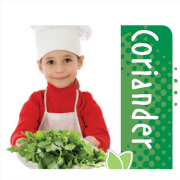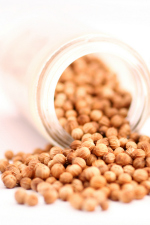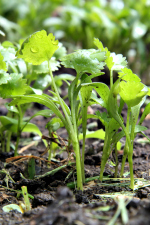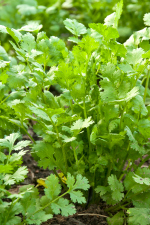Coriander, or ‘cilantro’ as the Americans call it, is a very popular herb used in Asian cooking and salads. It has a pungent, spicy flavour that some people love and some people hate. It really is a matter of taste.
Coriander is a very fast growing plant and can be ready to harvest within just a few weeks of planting. It prefers humid, hot weather but if it gets enough water and a bit of extra shade, it can still be grown during summer in the drier areas of Australia.
PLANTING
If planting in winter and spring, choose a spot in the garden that gets at least 6 hours of full sun every day but in summer, dappled shade is much better. Prepare the garden bed by removing any weeds and digging in lots of compost and organic matter so that the soil holds lots of water. Use a dibbler or big stick to make small holes about 20cm apart and gently place one seedling into each one, pushing the soil around the roots. Water the seedlings lightly.
Coriander is one of those plants that probably grows even better in pots than in the ground. The leaves grow large and lush and the great thing is that several pots can be planted about 4 weeks apart so that there is always a steady supply of coriander.
To grow coriander in a pot from seed, choose one that is at least 20cm deep and 20cm across and fill it with premium potting mix. Sprinkle in a few seeds and cover with a centimetre of potting mix and water lightly. Put the pot in the sun, keep it moist by watering every day and within four few weeks, the coriander will be ready to harvest.
To grow from seedlings, simply plant one seedling in each pot or choose a large tub and plant several. Always use a premium quality potting mix and keep it well watered.
CARE AND MAINTENANCE
Coriander hates it when the soil dries out and sometimes this will make it ‘bolt to seed’ . This means that a long hard stem will grow from the centre with a flower head on it which is full of seeds. These might drop to the ground and possibly grow but as the plant bolts, the remaining leaves become bitter and are not very nice for eating and the whole thing quickly dies.
To stop this from happening and to extend the harvest, make sure the soil doesn’t dry out and liquid fertilise every fortnight.
HARVESTING
Being such a fast growing plant, coriander needs to be harvested often. If you leave the leaves on the plant for too long they can become tough and perhaps a bit yellow. Start harvesting within a few weeks of planting and when you need the leaves for your cooking. Take the outside leaves first because the new leaves grow from the middle. Pinch the stem at the base of the plant to remove them.
To store harvested coriander, wrap the coriander stems and leaves in wet paper towel in a plastic bag in the fridge. It wil last for several days.
HOW TO EAT
Coriander was the original confetti used at events but now it is very popular in salads and as a herb. The leaves can be scattered over Asian style dishes or put through salads though it can also be used in cooked dishes but should be added right at the end just before serving as the heat of the food is all that is needed to warm them through.
Coriander root has a more intense flavour and is also common in Asian dishes so it shouldn’t be wasted. To prepare it, wash the roots well and use a very small knife to lightly scratch away any remaining dirt or rough sections. Then, chop the root up ready to be put into the wok or frypan.
Find great recipes in the Smarty Plants Kitchen.
HOW THEY GROW
Coriander seed is quite large and has two halves; when it is planted, it grows two seedlings. The young plants look just like mature coriander plants with thin green stalks that have very thin, frilly leaves on the end. As the coriander plant gets older, its leaves become even more frilly and eventually a flower spike grows from the middle which makes more seed to grow more plants.
FAST FACTS
Botanical Name: Coriandrum sativum
Life Cycle: Annual
When to Grow: Can be grown all year in cool or humid areas but in dry, hot areas is best grown from autumn through to spring.
Height/Width: 30cm x 30cm.
Requirements: Plant in full or part sun and be sure not to let the soil dry out.
Nutritional Benefits: A very good source of dietary fibre, thiamin and zinc as well as vitamins A, C and E though you would need to eat quite a lot of it. Also high in antioxidants.




